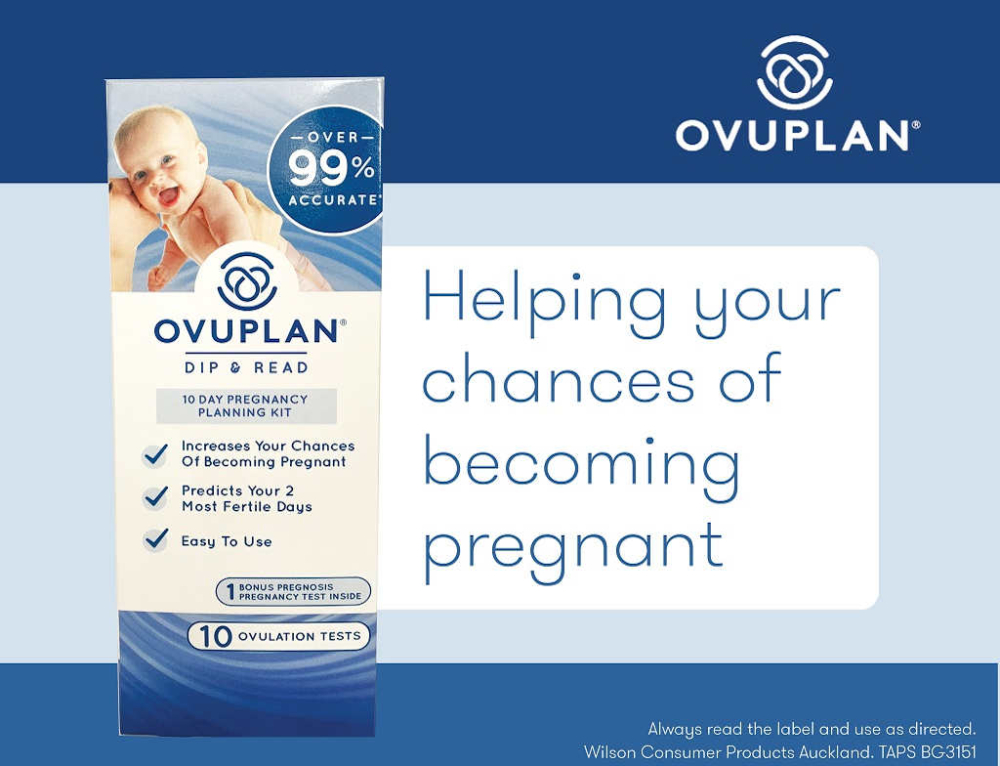What is a miscarriage?
The term ‘miscarriage’ describes the spontaneous abortion of a pregnancy before 20 weeks gestation. Miscarriage is the most common cause of the loss of a pregnancy.
According to SANDS – the pregnancy, baby and infant loss support group organisation – the rate of miscarriage is extremely difficult to calculate because the majority of women miscarry before they know they are pregnant. However, Sands says that every year in New Zealand, over 700 babies die between 20 weeks gestation, and 12 months of age. In excess of 10,000 die as a result of an early loss prior to 20 weeks gestation.
The estimated rate of miscarriage is 50 percent of all conceptions
The estimated rate of miscarriage in all ‘diagnosed’ pregnancies is between 15 and 20 percent
The estimated rate of miscarriage in ‘diagnosed’ pregnancies of women over 45 years is 75 percent.
Most miscarriages occur in the first 12 weeks (first trimester) of pregnancy and research has shown that the risk of miscarriage drastically falls throughout the first trimester – going from 9.4 percent at 6 weeks to 0.7 percent at 10 weeks.
 Miscarriage vs stillbirth
Miscarriage vs stillbirth
While the terms ‘miscarriage’ and ‘stillbirth’ both describe the death of a baby in utero, they are not interchangeable terms.
Stillbirth is the death of a baby before or during birth from the twentieth week of pregnancy onwards, or 400g birth weight.
Any baby who is stillborn must be registered as a stillbirth, and a birth certificate can be issued. Miscarriages do not have to be registered.
 Types of miscarriage
Types of miscarriage
Miscarriage is the most common form of pregnancy loss and often describes a process rather than a single event. There are many different types of miscarriage, including:
Chemical pregnancy
Chemical pregnancies are very common and, despite the name, the term does not describe a ‘false positive’ pregnancy. Chemical pregnancies occur very early – usually during the first six weeks – in pregnancy. They occur so early that many women never realise they were pregnant.
A chemical pregnancy occurs when pregnancy is confirmed by testing the hCG hormone in either the urine or blood, but before the pregnancy has progressed sufficiently to have it confirmed by ultrasound.
Symptoms of a chemical pregnancy are vaginal bleeding after a pregnancy has been confirmed and hCG levels that are falling rather than rising.
Causes of a chemical pregnancy are extremely hard to pinpoint, but experts estimate that about 60 percent of all miscarriages occur due to genetic abnormalities and so it is extremely likely that this is the cause of most chemical pregnancies.
Complete miscarriage
A miscarriage is considered to be ‘complete’ when all the pregnancy tissue has been passed, the cervix is closed and there is no sign of the pregnancy sac in the uterus. A complete miscarriage is common before 12 weeks, and means that no intervention is required beyond a medical professional confirming that the miscarriage is, in fact, complete.
Complete miscarriages are less common after 12 weeks, at which point they are called ‘incomplete miscarriages’ and some medical intervention is required.
Symptoms of a complete miscarriage include bleeding and cramping that resolves itself without any medical treatment after a few days.
Incomplete miscarriage
An incomplete miscarriage occurs when some of the pregnancy tissue remains in the uterus.
Symptoms of an incomplete miscarriage are continued cramping and bleeding, which indicate that there is retained tissue in the uterus that could cause infection if not removed.
Treatment for an incomplete miscarriage is most often a medical procedure – usually done under general anaesthetic – called dilatation and curettage (D&C). This describes the dilation of the cervix, followed by the scraping of the endometrium (the lining of the uterus) using a curette, and removing the contents.
Drug treatment may also be used to manage an incomplete miscarriage. Misoprostol, a synthetic prostaglandin which causes contractions and is used to start labour as well as terminate pregnancy, has been used with success to expel the retained tissue of an incomplete miscarriage.
Threatened miscarriage
A threatened miscarriage occurs whenever there is vaginal bleeding, beyond spotting, during pregnancy. The cervix usually remains closed during a threatened miscarriage and there are no blood clots or tissue passed.
Bleeding is common in the first trimester, with estimates that one in every four pregnant women experience some type of bleeding in early pregnancy. Bleeding should always be investigated and its cause identified.
Inevitable miscarriage
An inevitable miscarriage describes a miscarriage that is imminent or underway.
Though sometimes following a threatened miscarriage, an inevitable miscarriage can occur suddenly and without warning. For this reason, they are often also referred to as a ‘spontaneous miscarriage’. The symptoms of an inevitable miscarriage – abnormal cramping, bleeding is heavy and increasing, cervix is dilated – cannot be stopped and the loss of the pregnancy will always be the outcome.
Missed abortion
A missed abortion, or missed miscarriage, occurs when the embryo dies but is not expelled from the uterus, so the cervix stays closed and there is no bleeding or cramping.
Symptoms of a missed abortion are the loss of pregnancy symptoms, however, if the placenta continues to produce pregnancy hormones, pregnancy symptoms can continue after the death of the embryo.
A missed abortion is confirmed by ultrasound, which will show the baby being smaller than expected as well as missing a heartbeat. After confirmation, the miscarriage can either be left for a time to see if it will naturally be expelled from the body, or intervention can be taken to remove the pregnancy tissue from the uterus.
Ectopic pregnancy
An ectopic pregnancy – sometimes also referred to as a ‘tubal pregnancy’ – describes a pregnancy that develops outside the uterus, most commonly in the fallopian tubes. It occurs when the fertilised egg implants somewhere other than the uterus. Most ectopic pregnancies end in miscarriage as the uterus is the only place that can sustain a pregnancy and support the placenta with a blood supply that is life-sustaining.
Symptoms of an ectopic pregnancy can be confusing as they are often similar to a miscarriage, and include bleeding, sudden pain in the abdomen and cramps on one side of the pelvis. If left, an ectopic pregnancy can result in a ruptured fallopian tube, which can be life-threatening.
An ectopic pregnancy should be considered a medical emergency and will require immediate treatment, which often involves surgery, as it can lead to serious maternal complications if left.
Blighted ovum
A blighted ovum, also called an ‘anembryonic pregnancy’, occurs when the fertilised egg implants into the uterus but the cells do not continue to divide.
A blighted ovum will produce enough hCG hormone to return a positive pregnancy test, but it will miscarry between 7 and 12 weeks. A blighted ovum is often first detected through ultrasound when a small empty sac is viewed with no baby inside.
Like a missed abortion, the blighted ovum can either be left for a time to see if it will naturally be expelled from the body, or intervention can be taken to remove the pregnancy tissue from the uterus.
 Why do miscarriages occur?
Why do miscarriages occur?
It is estimated that about 50 percent of all miscarriages that occur in the first 12 weeks of pregnancy are the result of chromosomal abnormalities in the baby.
Miscarriage after 12 weeks is usually due to other factors, including:
Age – The risks of miscarriage, ectopic pregnancy and stillbirth increase with the age of the pregnant woman. Half of all pregnancies result in miscarriage in women over the age of 42. Studies have also shown that the risk of miscarriage is significantly increased if maternal age is over 35 years as well as the paternal age being over 40 years.
Placental problems – The placenta is the life support for a developing foetus and performs many vital functions during pregnancy, including supplying oxygen and nutrients to the baby as well as carrying waste and carbon dioxide away. If any of these functions don’t work, and the health of the foetus is compromised, miscarriage may occur.
Hormonal problems – Miscarriage is more likely in women with untreated thyroid disease or diabetes. Women with endometriosis or polycystic ovary syndrome (PCOS) also have a higher risk of miscarriage. Women with very irregular periods can find it harder to fall pregnant and then have a higher risk of miscarriage.
Infections – Coughs, colds and minor infections are unlikely to cause miscarriage, but high temperatures and some infections such as German measles, listeria, toxoplasmosis and cytomegalovirus (CMV) can cause miscarriage to occur.
Anatomical problems – An irregularly-shaped uterus can hinder the healthy development of a foetus, as can fibroids. A weakened cervix, also referred to as an ‘incompetent cervix’, where the cervix begins to open in late pregnancy due to the weight of the uterus, can also result in miscarriage. A procedure called cerclage (or ‘stitching the cervix’) can be taken to reinforce the cervix and ensure that it stays closed through pregnancy.
Lifestyle factors – Smoking, taking drugs and drinking alcohol and caffeine during pregnancy increase the risk of miscarriage. Ongoing poor nutrition may also a contributor to miscarriage.
 Causes of recurring miscarriages
Causes of recurring miscarriages
Miscarriages are considered to be recurrent when three or more consecutive miscarriages have occurred.
Following three consecutive miscarriages, the risk of further miscarriage is approximately 40 percent. One percent of couples trying to get pregnant have recurrent miscarriages.
After three miscarriages in a row, it is recognised that there may be a specific reason for the pregnancy loss. While no underlying cause is found in some cases, known causes of recurrent miscarriage include:
Chromosomal problems – About half of all miscarriages occur because of abnormal chromosomes, which is usually a spontaneous problem rather than an inherited problem. An inherited chromosomal problem could be the cause of recurrent miscarriage, the most common of which is a chromosomal defect known as ‘balanced translocation’, which results in some genetic information being duplicated and some being missed altogether.
Blood clotting problems – While there are some inherited blood clotting disorders that can cause miscarriage, the most common condition is Antiphospholipid syndrome (APS), also known as Hughes syndrome or ‘sticky blood syndrome’. There is no cure for this condition but the symptoms are treatable and risk of miscarriage may be reduced.
Structural problems – These include most commonly, a short cervix (incompetent cervix), cervical weakness or an abnormally-shaped uterus.
Immunological causes – Antiphospholipid syndrome (see above) is an autoimmune disorder where the immune system creates antibodies involved in blood clotting, making the blood thicker and stickier. Diabetes mellitus, particularly where the condition is poorly managed, can cause recurrent miscarriage. Polycystic ovary syndrome (PCOS) is also thought to be a possible cause.
The risks of recurrent miscarriage are increased with:
Age – Maternal age over 35 years and paternal age over 40 years will increase the risk of miscarriage.
Being outside ideal weight range – Being very overweight or very underweight will increase the risk of miscarriage.
In 50 to 75 percent of couples trying to conceive, no cause for recurrent miscarriage is found.
 Can a miscarriage be prevented?
Can a miscarriage be prevented?
With an estimated 50 percent of all miscarriages occurring as the result of chromosomal abnormalities, there is little you can do to prevent most pregnancy losses.
However, there are some lifestyle changes you can make to reduce the risk of miscarriage. These include:
Exercise in moderation – Getting active is a great way to maintain a healthy pregnancy, but avoid excessive physical activity or activities such as skiing or horse riding that may lead to abdominal-area injuries.
Be mindful of what you eat – There are some foods that you should avoid when pregnant. In particular,listeria and toxoplasmosis are two infections linked to miscarriage that are caused by eating unpasteurised dairy products (listeria) and handling and eating raw or uncooked meat (listeria and toxoplasmosis).
Check your immunisations – Have a blood test before you try to conceive to check your immunisation status. If you do need to be immunised, do this before becoming pregnant.
Manage health conditions – Chronic health conditions including diabetes mellitus, lupus, thyroid disease and epilepsy increase the risk of miscarriage. Managing these health conditions well will reduce the risk of miscarriage.
Get tested – Get checked for sexually transmitted infections.
Avoid tobacco, alcohol and drugs, and limit your caffeine intake – While this may seem obvious in relation to the ongoing health of mother and foetus, what is often less known is that they also increase the risk of miscarriage.
 What are the signs of miscarriage?
What are the signs of miscarriage?
Before 6 weeks
Miscarriage before 6 weeks will be similar to a menstrual period – mild cramping and bleeding, which may be heavier than normal. Small clots may appear.
6 – 13 weeks
Miscarriages experienced between 6 and 13 weeks are usually ‘complete miscarriages’ requiring no medical intervention. In this case, there will be some abdominal cramping as the cervix opens and the uterus contracts to expel the blood, clots, baby and placenta from the vagina. This process can take up to a couple of days. Once everything is expelled, the cervix will close and the bleeding will ease off over the following days.
All other symptoms of pregnancy – including morning sickness and breast tenderness – will disappear over a week or two as hormone levels return to pre-pregnancy levels.
Incomplete miscarriages, where the contents of the uterus are not expelled, require medical intervention, which usually results in an operation to remove the retained contents. Signs of an incomplete miscarriage include bleeding and clotting that continues and gets heavier over days.
Signs of infection are also evident – a result of the retained uterine contents – after the bleeding has ended. Fever, abdominal pain or tenderness, offensive discharge, as well as sudden onset of heavy bleeding may also be experienced.
14-20 weeks
Miscarriages after 14 weeks are termed ‘late miscarriages’. They are more commonly incomplete and require medical intervention.
The baby and placenta are much more developed at this stage and more likely to cause heavier bleeding. While the baby may be easily passed, often the placenta is fully or partially retained within the woman’s uterus. The physical signs of bleeding, cramping and pain can be similar to an early miscarriage, but sometimes more severe and labour-like.
PLEASE NOTE: Not all bleeding in pregnancy is a sign of miscarriage. One in four women will bleed in early pregnancy and not all will end in miscarriage. All bleeding in pregnancy should be investigated by a health professional however to determine the cause.
 How will I feel after I miscarry?
How will I feel after I miscarry?
All women have different experiences after miscarriage.
Emotionally, any feeling is normal and valid, and they run the gamut from grief and despair to relief. You may feel guilty – that you could have prevented the loss or that you did something to cause it. You may feel guilty about feeling guilty.
Giving yourself the space and time to feel whichever emotion you’re feeling is the kindest thing you can do for yourself. There’s no right or wrong way to cope after a miscarriage.
If you are feeling like you aren’t coping with the pregnancy loss, or need more support than you are getting at home, talk to your GP about getting some counselling advice or seek out a support group that will help you get through this experience.
 Miscarriage support services
Miscarriage support services
Your family doctor or obstetrician. If you would like further support, they can refer you to a counsellor specialising in loss.
Miscarriage Support Auckland is not only for Aucklanders, and provides information and support for anyone who has lost a baby.
Sands NZ supports parents and families that have experienced the loss of a baby at any stage, and provides a list of local support groups.
Online forums can provide support from others who have shared similar experiences.







Leave A Comment
You must be logged in to post a comment.